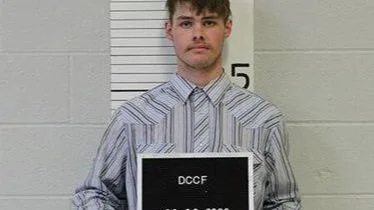Two South Dakota men charged in Montana murder that has ties to Ben Affleck crime drama, "The Town"
Part 1
A murder trial in a small Montana town included surprising evidence and “witnesses,” as a scene from the 2010 crime thriller “The Town,” starring Ben Affleck and Jeremy Renner was shown twice and mentioned numerous times. Two South Dakota men were charged with murder, and one has been convicted, while the other awaits trial.
Jake Burghduff of Ludlow, S.D. (seen above in an image from Dawson County Correctional Facility in Glendive, Mont.) , was found guilty of deliberate homicide by a Prairie County, Mont., jury on Wednesday, Aug. 23, and faces a maximum sentence of 100 years. Sentencing is set for 3 p.m. Mountain time on Tuesday, Oct. 17.
He was charged with being a participant in the Jan. 23 shooting death of Isaac Carrier, who was in bed, likely asleep, in his Fallon, Mont., apartment when he was killed.
Before he drove to Montana with Sterling Brown, who is accused of actually firing the shot that killed Carrier, Burghduff was sent a YouTube video of Affleck and Renner from “The Town.”
Affleck’s character Doug MacRay, a Charlestown, Mass., bank robber, asks his lifelong friend and fellow thief James “Jem” Coughlin, played by Renner, for some assistance.
“I need your help,” he said. “I can’t tell you what it is, you can never ask me about it later, and we’re going to hurt some people.”
Coughlin responds by asking what car they are going to take. They put on hockey masks, break into a home and beat and threaten two men. Coughlin jams a handgun into one man’s face before shooting him in the leg and warning him to leave Boston.
That scene served as a message from Brown, who is from Camp Crook, S.D., to Burghduff, according to prosecutors. The fact that Burghduff responded to the text, drove into
Ludlow, an unincorporated community in far northwest South
Dakota, and met up with Brown showed he was willing to turn the movie clip onto a horrific reality.
After Brown sent the clip, Burghduff replied in a text, “I’m confused lol.”
Brown texted back, “Listen to it again let me know if I can come over.”
Burghduff seemed to get the message then.
“I’m still confused, we gotta hurt someone or something?” he responded, noting his father Lex and a female employee were in the living room.
“Something like that,” Brown wrote. “You available for pickup?”
Burghduff said he could meet him in Ludlow.
“Alright can’t say much else on here,” Brown replied.
Affleck’s name was mentioned repeatedly during the trial. Renner, who was nominated for a Best Supporting Actor for his performance, was referred to as “the other actor,” since his name did not come immediately to mind during a closing argument. Affleck not only starred in the movie, he directed it and co-wrote the screenplay.
Efforts to contact him were not successful. His publicist Jennifer Allen was on jury duty, her voicemail said.
The attack on Carrier had some similarities to the movie scene, but it differed in other ways. Burghduff told investigators Brown put a silk mask over his face before walking to Carrier’s apartment. Burghduff said he remained in Brown’s
pickup and did not see his friend enter the building, nor did he hear the single gunshot, since the windows were up against the winter weather.
Prosecutors actually believe he accompanied his friend inside the fourplex.
In the movie, the characters played by Affleck and Renner break down the door with a sledgehammer and attack two men. While Coughlin threatens one man and then shoots him, no one is killed.
Carrier was shot just once, in the back of the head. Because of the fire damage to his body, when bullet material was recovered, it was impossible to tell the caliber. Brown was carrying a 45-caliber ACP semi-automatic handgun, black with a wooden grip, while Burghduff had a Ruger .22-caliber Magnum revolver.
Charging documents said Brown poured gasoline on Carrier and throughout the apartment before setting it on fire. There is no fire in the scene from “The Town.”
In the real crime, Brown and Burghduff left their cell phones in Burghduff’s vehicle, according to a confession Burghduff gave to investigators, and drove three hours through back roads to Fallon, Mont., stopping in Baker, Mont., to fill a gas can. When they arrived in Fallon, Brown parked his pickup, grabbed his handgun and the gas can, according to Burghduff. He walked through the cold, snowy night toward the small wooden house at 605 Whittier Ave. that had been divided into four apartments.
The door to Carrier’s apartment was unlocked, Sheriff Keifer Lewis told me.
“It is very common practice here in frontier Montana,” Lewis said. “Just not a lot of houses that are locked.”
Once inside, Brown fired a single shot into the back of Carrier’s head from within 6 inches to 2 feet, far enough to convince investigators this was not suicide, according to Montana Division of Criminal Investigation Agent Brad Tucker’s testimony.
Carrier’s body was soaked with gasoline, which also was scattered through the apartment, and the fire was started. The electric stove also had been tampered with, but it’s unclear why. A smoke alarm in the hallway had been disabled.
Sheriff Lewis testified on Monday, Aug. 21, that Carrier’s body was laying on the bed at an angle, on his stomach, head turned toward the wall, left arm under his body, right arm laying through the bed frame and on the floor.
The mattress had entirely burned away.
Montana State Medical Examiner Dr. Walter Kemp, who also testified on Aug. 21, said Carrier did not die immediately when he was shot. The autopsy showed the presence of smoke in Carrier’s lungs, proof he was still alive when the fire was set.
Lewis said on the stand that he attended the autopsy, and when the body bag was opened, he smelled a strong odor of a petroleum product. Investigators collected clothing samples which were bagged and sent to a lab, which confirmed the fuel was gasoline.
Explosive evening in quiet town
Carrier, a ranch hand who favored Western clothing and lived a cowboy lifestyle, owned several guns and had a supply of ammunition. When emergency responders arrived at the scene, they had to contend with bullets and shotgun shells exploding. No one was injured.
Sheriff Lewis, who was at the scene that night, said unlike movies and TV shows, ammo ignited by a fire is not very dangerous. The bullets and shells pop when the powder inside them heats up and expands and the shrapnel and other material lands on the floor, he said.
“It sounds like a fireworks stand going off but no projectiles go anywhere,” Lewis said.
While on the witness stand, DCI Agent Tucker revealed what he learned during a lengthy interrogation of Burghduff at the Spearfish Police Station on Feb. 7.
Burghduff, who turned 21 just a few days after the killing, is being represented by Montana public defenders Hailey Forcella and Michael Haase of Miles City. They declined to comment when contacted before and after the trial, and said their client was not to be contacted.
At a July 23 hearing before the trial, Forcella said investigators had no evidence that Burghduff and Brown of Camp Crook were involved in Carrier’s death until Burghduff was convinced to disclose details of the murder at the Spearfish Police Station.
“Had any defense attorney been there, they would have said, ‘Don’t talk,’” she said.
Forcella said Tucker used promises of a lighter sentence mixed with threats, including the possibility of the death penalty, to convince Burghduff to talk. She said he also detained Burghduff against his will and searched his cell phone without his consent.
“No matter how slight the intrusion, these were unlawful searches,” Forcella said.
Tucker, under questioning from Montana Assistant Attorney General Dan Guzynski, denied those allegations.
He said Burghduff drove from his family home to meet with him willfully, and always had the right to leave the police station, since he was not under arrest for several hours. Burghduff was read his rights and told he did not have to answer questions. But he spoke to Tucker for hours, and eventually said he was with Brown when they drove to Fallon and Brown killed Carrier.
Brown has denied he killed Carrier and said he was not in Fallon on Jan. 23. Tucker said he doesn’t believe Brown, and wanted Burghduff to tell the truth.
“I treat people the way I want to be treated, with respect,” he said. “I can be firm, but I treat people with respect.”
Tucker said he was trying to help Burghduff, whom he did not believe had actually killed Carrier. Instead, he said repeatedly, he was convinced Brown had committed the murder over a bitter custody dispute between his wife, Katie Bivens, and Carrier, her ex-husband. A custody hearing was set for Jan. 25 — two days after Carrier was killed.
Sections of the interview conducted by Tucker and fellow DCI Agent Craig Baum with Burghduff were shown during the hearing. They met in a small room at the Spearfish Police Department that is equipped with video cameras.
The Montana investigators had met with Brown and Bivens at the Spearfish Police Department on Jan. 31, and they denied having any involvement in Carrier’s death. Brown claimed he was driving around western South Dakota and southwestern North Dakota with Burghduff.
Tucker said he believed that was “a bunch of crap,” and was convinced that Burghduff and Brown had talked and prepared a story to cover their actions that night.
“I have no doubt in my mind Sterling’s the guy who did this,” Tucker told Burghduff during the Feb. 7 interview. He said after interviewing him, he came to see Brown as a “pretty cocky son of a bitch” who thought he was literally getting away with murder.
However, Tucker saw Burghduff as someone who was dragged into a serious crime without fully realizing the consequences. He urged Burghduff to “come clean” and admit what happened.
Tucker said if he did, he would serve a far shorter prison term.
“I don’t think you’re capable of this. I don’t think you’re a killer,” he said. “What side of the law do you want to be on?
“Let me help you out in the long run,” Tucker said. “You didn’t have any cause to kill this individual. But Sterling did.”
When asked by the defense why he showed two photos of Carrier to Burghduff, including one of him after he had been shot in the back of the head and then soaked in gasoline and burned, Tucker said he felt it was necessary.
“I’m putting a face to the individual who was brutally murdered,” he said.
Tucker said he thinks most people would feel empathy for Carrier and would want to see justice done. He said he was trying to help Burghduff avoid a charge of deliberate homicide.
But that charge was eventually filed, and two earlier counts of arson and tampering with evidence were dismissed.
In Part 2, a verdict is reached.
Tom Lawrence has written for several newspapers and websites in South Dakota and other states and contributed to The New York Times, NPR, The Telegraph, The Daily Beast and other media outlets.






